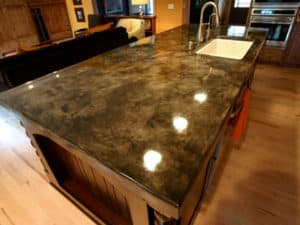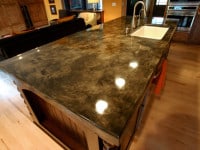
Concrete countertops are a very durable option for kitchens and bathrooms. They can be very attractive too. Many homeowners give them a one-of-a-kind look using concrete countertop stamping and staining techniques. Here’s an introduction to these techniques that will help you decide if this is an approach you want to take with your home’s counters.
Countertop Stamping Techniques
Most concrete countertops are poured on site. The frame is built on top of cabinetry and the concrete is added. As it begins to set, the stamping begins. Stamps in a wide variety of patterns and styles are used to imprint the concrete. The stamp is applied while the concrete is still soft enough to receive it, but not so wet that pattern impression will fill back in.

Concrete countertop contractors will do the work, or many handy homeowners take it on as a DIY project. Local countertop companies often have sets of stamps they rent, or have single-use stamps they sell. They can be found online and at building supply stores in a wide range of styles.
When choosing a concrete countertop with plans to stamp it, some DIY enthusiasts attend a local training seminar at a home improvement store or a concrete company. It might also be a good idea to do a “test” slab outside to get experience with the process. It’s impossible to fix a botched job!
There is a wide variety of stamp types from which to choose. These include slate, brick, tile, stone or flagstone, sunburst, river rock styles and more. Some companies will also produce custom stamping designs for a fully unique countertop.
Countertop Staining Techniques
A second compelling technique to use on concrete countertops is staining with acid. The process is done only after the concrete countertop is fully cured. There is a large variety of colors and styles that can be achieved with concrete staining. It’s possible to give the countertop the look of richly veined marble for example, or natural stone, leather or wood.
Stencils may be used in staining as well. The stencil is laid on top of the countertop and the acid is applied with a brush to the open areas. Dozens of patterns are available, with almost any type of design you can imagine.
Contractors skilled in concrete acid staining can take your ideas and bring them to life in the concrete. Or, if you are comfortable with semi-challenging DIY projects, you can tackle the job yourself. Using a practice slab to get comfortable with the staining technique and to test the color to make sure it is what you want is a very good idea.
The concrete countertop must be thoroughly cleaned before you begin staining. If the concrete countertop has been in use for some time, it may need to be sanded or lightly ground before staining. Once the job is done, the concrete must then be sealed for durability and to make it easier to clean. Epoxy sealers are most often used because they produce a nonporous surface, and like any concrete sealer, need to be reapplied periodically.
The Concrete Canvas
Concrete sounds dull, but it can actually be a fantastic medium for producing a uniquely beautiful countertop. Using concrete countertop stamping and staining techniques, many homeowners find a creative outlet that can be otherwise limited by countertop materials natural stone or recycled glass.
